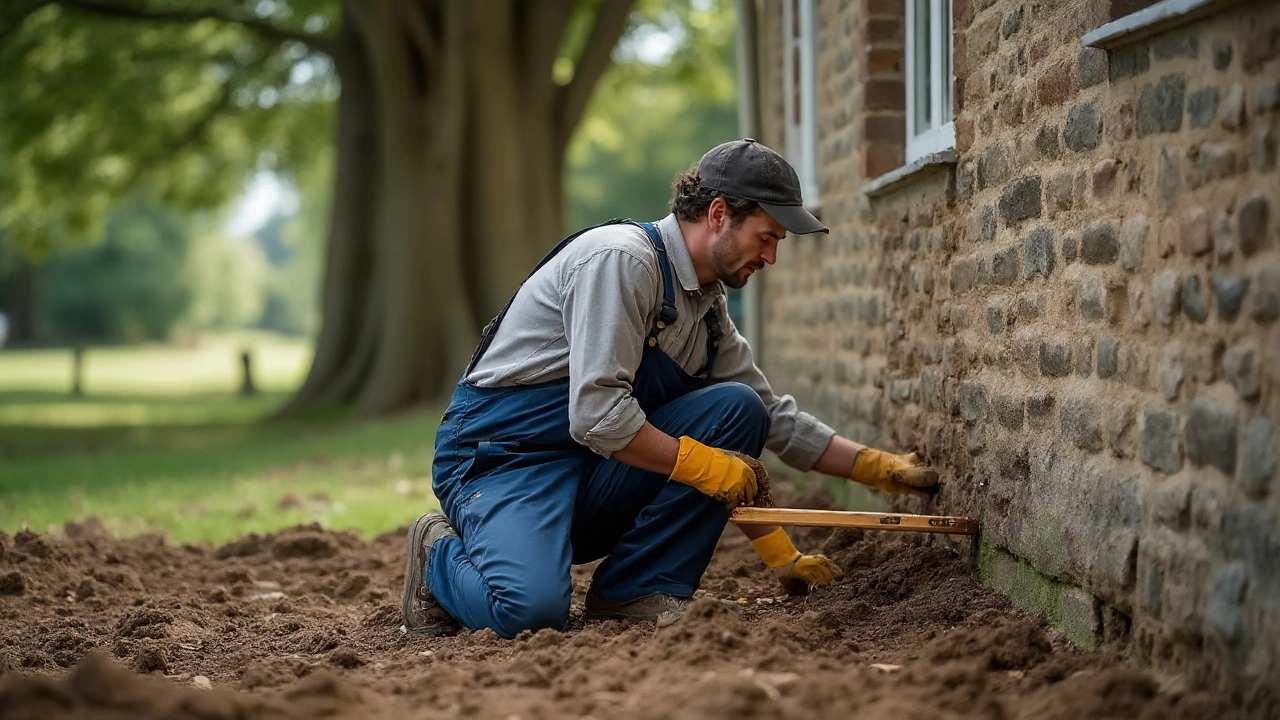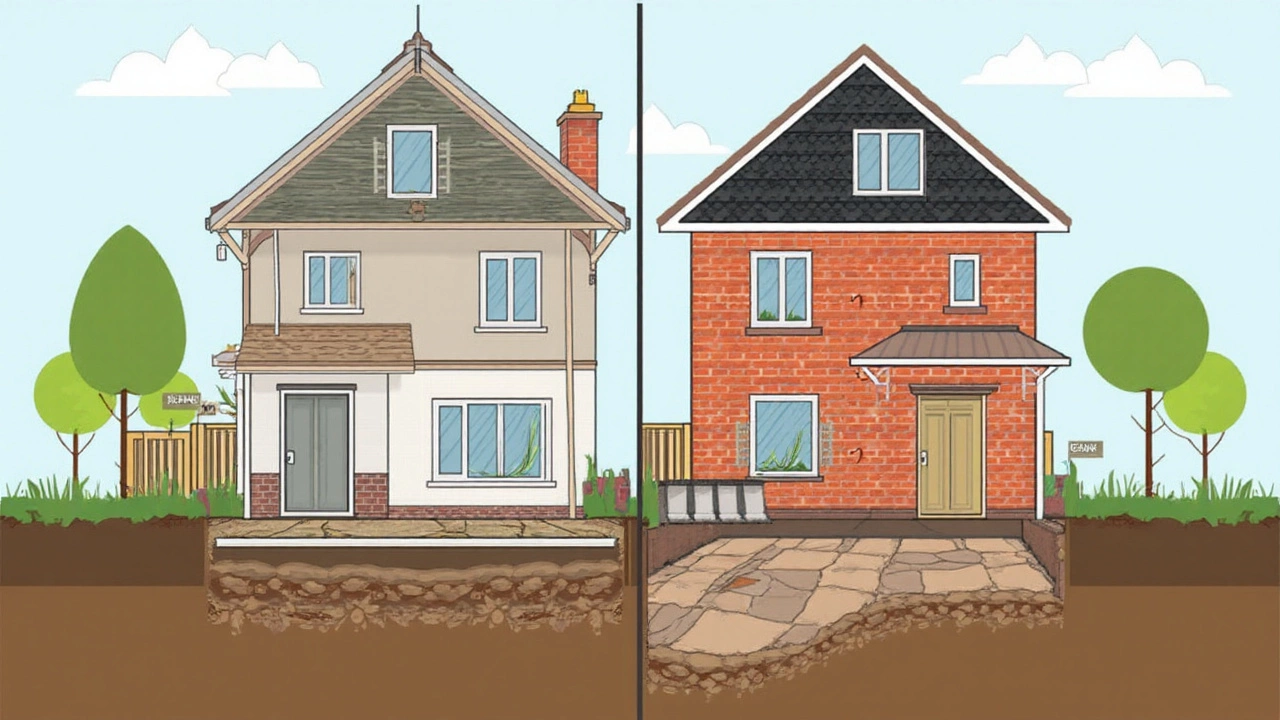Cracks zigzagging across your walls, doors sticking when the weather shifts, uneven floors that make your furniture wobble—foundation problems are the kind of issue you can’t ignore. Not fixing them is like ignoring a toothache, hoping it’ll just ‘go away.’ It won’t. The cost? It rises quickly, and can blow right past fifteen grand in the U.S. if you wait. But jump on the symptoms early, and some fixes might add up to less than your last vacation. Still, foundation problems seem almost mythical. How can something buried in the dirt create such chaos up above? Well, the truth is, your home’s entire stability comes down to what’s happening under your feet. Knowing how to solve foundation problems means you control your home’s future value—not the other way around.
Spotting Foundation Problems: Signs You Can't Ignore
Recognizing the early warning signs of foundation damage saves you stress and serious money down the road. I see homeowners all the time who only call for help after they’ve painted over cracks three times and things are now falling off shelves. If you want to stop disaster before it starts, it pays to know exactly what you’re looking for—and when to worry.
Let’s kick off with the obvious. Not all cracks mean doom, but certain ones scream foundation problems. Vertical cracks, less than a quarter inch wide, are usually the result of normal settling. If you spot a crack wider than a pencil or ones running diagonally or in stair-step patterns, pay attention. Cracks that get longer or wider over time are serious red flags.
Next up: watch your doors and windows. If they’re suddenly hard to open or close or you see gaps forming at the frame, your house may be tilting. Floors that feel sloped, bouncy, or look warped? Put down the level and check. One stat that knocked my socks off: the National Association of Home Builders actually lists 'uneven floors' as the number one interior symptom for foundation failure. If you see your fireplace or chimney pulling away from the house, treat that like your home is calling for help.
Water issues matter too. Check your basement or crawlspace after heavy rain. If water pools or you detect a musty, damp smell, your foundation drainage may already be in trouble. That goes double if you see white, chalky streaks (that’s efflorescence; it means water is evaporating and leaving behind mineral deposits).
Keep an eye on your exterior, too. Is your foundation wall bowing? Does the brickwork show any new or growing gaps? Even minor shifts, like soil pulling away from the base, could be early warnings. On older homes, watch out for pests; termites love tiny foundation cracks, and where they go, rot follows.
Busting one myth: if you’re in an area with clay-heavy soil, your risk jumps way up. According to the American Society of Civil Engineers, about 60% of U.S. homes are built on soils with high shrink-swell potential. When the ground gets wet, clay expands; when it dries out, it shrinks away. This shift puts stress on your foundation every year—sometimes by several inches. No wonder Texas homeowners are foundation-fix regulars.
One more thing: don’t trust a single look. Take photos, measure cracks, and check every couple of weeks. Track the change so you know if things are staying put—or getting much worse. People always ask, “Is this normal?” The only way to know is to watch it. Documenting makes it much easier (and cheaper) when it’s time to call a pro.

Why Foundations Fail: The Root Causes Behind the Cracks
Now that we know what trouble looks like, it makes sense to understand where all the problems come from. Solving foundation problems always starts with fixing the underlying cause, or you’ll be doing the same repairs again next spring.
Let’s start underneath: soil is not just dirt. It shifts, contracts, swells, and erodes. Expansive soil is public enemy number one for homes. During wet seasons, it soaks up water, expands, and pushes against the foundation. In the dry months, it shrinks and leaves the foundation unsupported. This cycle—called “shrinking and swelling”—is why so many U.S. homes get cracks after a drought, or following a big rain.
But clay isn’t the only culprit. Poor drainage, either from clogged gutters or sloping ground, is just as relentless. When rainwater pools near your foundation, it doesn’t just sit. It works its way down the sides, washing soil away and creating voids. The foundation now sits on air, and gravity helps it sink unevenly. A study out of Georgia State put home foundation repair costs in areas with poor drainage 30% higher than places with well-managed water runoff. That’s a fixable problem if you spot it early.
Trees often get blamed, but there’s truth to it: the roots of a mature oak can pull hundreds of gallons of water a day out of clay soils. The soil shrinks, your home sags. Same story with big shrubs planted right next to your house—roots can disrupt foundations and drainage in ways most folks never see coming.
Other causes are human-made. Foundation footings that were poured too shallow, or without proper steel reinforcement, simply aren’t made to last. That’s especially true in parts of the U.S. hit by shifting frost lines or areas that used outdated building codes. A lot of homes built before the 1970s, especially in the Midwest, just weren’t poured as deep as they needed to be—and now homeowners are paying the price.
Earthquakes and flooding also take their toll, even far from fault lines. The 2011 Virginia earthquake, small as it was, caused cracks in homes up and down the East Coast because the foundations weren’t built for movement. Even construction work next door can shake things loose—deep digs or heavy trucks create vibrations that travel through the ground, leaving you with a crooked doorstep.
Here’s a fast breakdown of what can go wrong (and why):
- Foundation cracks: Caused by soil movement, water damage, or weak construction.
- Bowing/bulging foundation walls: Usually bad drainage or expanding soil.
- Settlement/sinking: Voids from eroded soil or improper fill under foundation.
- Upheaval: More rare, but happens when wet clay expands and pushes foundation up.
- Rot or pest damage: Moist, cracked areas attract termites and rot, undermining stability.
Most people don’t know that the lion’s share of “expensive emergency” foundation repairs could’ve been avoided with two simple things: taking care of water runoff and building a buffer zone of three to five feet where no big trees or shrubs are planted next to the foundation. Soil prep and water control seem boring, but they’re absolute lifesavers in the long run.
Below is a quick table showing some causes and their frequency, according to HomeAdvisor’s data pulled through the last 5 years:
| Cause | Percentage of Foundation Problems |
|---|---|
| Expansive Soil | 54% |
| Poor Drainage | 27% |
| Tree Roots | 11% |
| Poor Construction | 6% |
| Natural Disasters | 2% |
Maybe not surprising, but it’s pretty clear what problems show up most often. If you don’t want a surprise repair bill, your best bet is to tackle soil and water issues before anything else.

Proven Ways to Solve Foundation Problems: Fixes That Actually Work
Let’s say you’ve spotted the signs, traced the cause, and now you want to know what actually works to solve foundation problems. The internet is full of magic “solutions,” but some repairs might as well be held together with duct tape. Only a handful of methods are proven—used by real pros, and trusted by engineers who back up their work with warranties.
Let’s walk through the approaches that really deliver, starting with the most basic and moving up to the heavy-hitters.
- Epoxy & Polyurethane Injections: If you only have minor, non-structural cracks (think: less than a quarter inch wide), these sealers can stop water, pests, and air from getting in. They don’t solve movement, just block leaks, but they’re affordable and quick—sometimes finished in a single afternoon.
- Exterior Waterproofing: This is the gold standard for stopping water from reaching your foundation in the first place. Crews dig down to the base, apply waterproof coatings and drainage mats, and install French drains. Not cheap, but once done, it can last decades and prevent most other water-related damage.
- Slabjacking (or Mudjacking): If your concrete slab is sinking or uneven, techs drill small holes and pump a concrete mix underneath, raising the slab back to level. It’s fast—sometimes just a day’s work. Works best for smaller fixes; big foundation shifts need more muscle.
- Piering and Underpinning: For the big jobs, this is what separates the hacks from the pros. Steel push piers or helical piers are driven deep into stable soil (sometimes 30 feet down) and attached to your foundation, lifting it back to its original height, and keeping it stable no matter how the soil moves above. Piering is expensive, but it’s permanent when done right. Helical piers are the go-to in the Midwest and South, while resistance piers are more common in cities with deep clay layers.
- Wall Anchors: If you’ve got bowing basement walls, anchors are driven through the wall and pulled against stable soil outside, slowly straightening the wall over time. These usually require less digging than full replacement, and the best systems come with long-term warranties.
- Drainage Correction: Sometimes, just regrading your yard, adding downspout extenders, or digging a French drain beats spending thousands on repairs that wouldn’t have been needed if the water had just been routed away from your foundation in the first place.
Too many homeowners do “band-aid fixes,” like patching cracks or slapping up waterproof paint but never fix the water or soil issues that caused the damage. If you don’t solve the root problem, the damage comes back. Think of it as treating the symptoms vs fixing the disease.
When it comes to real costs, here’s what you might expect, based on data from HomeAdvisor and the Foundation Repair Association (averaged for U.S.):
| Repair Type | Average Cost (USD) | Typical Lifespan |
|---|---|---|
| Epoxy/Pu Injection | $300 - $800 per crack | 10-20 years |
| Exterior Waterproofing | $5,000 - $12,000 | 20-40 years |
| Slabjacking | $700 - $3,000 per area | 10-15 years |
| Piering/Underpinning | $3,500 - $11,000 per pier | Permanently (lifetime warranty often) |
| Wall Anchors | $800 - $2,500 each | 30+ years |
This isn’t a DIY zone—unless your issue is strictly cosmetic, foundation repairs are worth bringing in an expert. Local pros know your soil and spot tricky issues homeowners miss. Most reputable companies do free inspections—just dodge scammers who rush you into huge jobs or “guarantee” everything with no contract.
If you’re the preventative type, maintenance is where your money goes furthest. Clean your gutters every season. Add downspout extenders to channel water away from your home. Every few years, walk your foundation with a clipboard, snap photos, and jot down measurements for future comparison. If you’re planting trees, keep them at least 15 to 20 feet away from your foundation, especially big species like oaks and maples. Fix small cracks with good-quality epoxy, and monitor them. Moisture meters in your basement or crawlspace can help you catch hidden leaks early.
At the end of the day, regular upkeep and fast action is how you stop the big-ticket repairs. Notice something new or weird about your walls, doors, or floors? Don’t wait to check it out—delaying only makes your foundation problem, and the cost, grow. Keep control of what’s under your feet, and your home stays strong for decades. Foundation problems are common, but with the right fixes, you won’t be repeating your repairs anytime soon.
